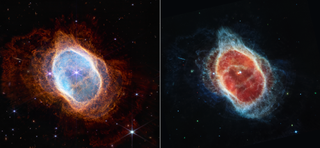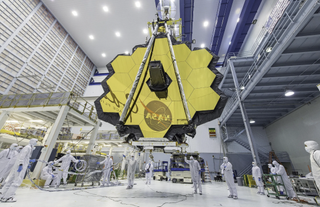James Webb Space Telescope's Images Are Safely Stored on a 68GB SSD
Your laptop's SSD is bigger, yes, but can it handle deep space?

At an event held at the Goddard Space Flight Center, NASA today shared the first batch of full-color images captured by the James Webb Space Telescope (JWST). Humanity's largest and most powerful space observatory ever to go into operation, the JWST stands at the forefront of human ingenuity. Yet despite that ingenuity, PC enthusiasts will laugh at the telescope's available storage space to safeguard some of the most memorable images ever to grace our screens: a 68GB SSD.
"Every image is a new discovery and each will give humanity a view of the universe that we've never seen before," NASA Administrator Bill Nelson said.
To be fair, this isn't just any SSD. In fact, it's referred to as a Solid State Recorder. Any electronic part that goes into a project such as the JWST must go through a grueling certification process. There are standards of reliability, speed, redundancy, and resistance to radiation that have to be met by the sum of its parts. The world's best SSDs may hold many times more data and operate thousands of times faster, but they'd all fail if only you could throw them high enough.

Let's be clear: the images themselves are awe-inducing. There aren't enough adjectives in the English language to gush at our ability to look so deep into the cosmos (and those colors!). But there are a million checkmarks that must be met between the moment the JWST captures one of these incredible, space-opera-like images, and the one where we can actually render them on-screen.

The JWST's humongous, 25 square meter main optic has been engineered to capture infrared light that stretches to 28μm in wavelength. And the wider the wavelengths that a sensor can capture, the more data it will produce for each image. This is as true for a cellphone-captured image as it is for the JWST. Everything, including color [those colors!], is data.
Due to how sensitive the JWST is, it can produce up to 58.8 GB of image data each day, leaving the historic Hubble and its maximum 2 GB of daily output huddled in a corner reserved for former champions.
The data writing itself is handled by the JWST's ISIM Command and Data Handling subsystem (ICDH), which can sustain a maximum data rate of about 48 Mbps. This is enough for the JWST to save around six 2048x2048 image files every 10.7 seconds.
That can be an issue. The JWST's 68 GB, radioactive-hardened SSD, which surely features way more over-provisioning than our mainstream SSDs, can be fully written through in a single day. In fact, depending on the schedule, the JWST's SSD can be filled in as little as 120 minutes. This means that the data must be continuously emptied from the SSD's banks, crossing the 1.5 million kilometers (~932 thousand miles) of space that separate the JWST from the pale blue dot of Earth, where they can be safely stored on NASA's servers — and your own digital devices.
The distance wasn't picked by chance, either, as it parks the JWST at Lagrange Point 2, one of the spots where gravity interactions between different celestial bodies cancel each other out, enabling as stable pictures as can be had in the tapestry of the cosmos. And so, the JWST must not only capture the images, but also radio them toward the Earth on a frequent basis.
The main communications system of the JWST, based on Ka-band frequencies, transmits data back to Earth on a 25.9 GHz channel at up to 28 Mbps. To empty its databanks, the JWST downlinks science data in two 4-hour contact windows per day, with each contact enabling the transmission of at least 28.6 GB of recorded science data to the ground.
A pair of slower radio channels in the S-band take care of other necessities. A 2.09 GHz uplink delivers future transmission and scientific observation schedules to the telescope at 16 kbps, which are scheduled 12 to 20 weeks in advance. A second, 2.27-GHz, 40 kbps downlink ferries the telescope's engineering and telemetry data, including operational status and systems health.
It's unclear why the JWST's storage tops up at 68 GB of usable data in a $10 billion-plus scientific effort — and a further 3% of that 68 GB is unavailable, as it's reserved for the engineering and telemetry data storage mentioned above. However, it's likely that the timeframe at which the JWST's contract was inked, as far back as 2003, had something to do with it.
Engineers further estimate that by the end of the JWST's estimated 10-year lifespan, only 60 GB of storage will still be available, due to cell damage from a variety of sources, including writes and radioactivity. That'll be just enough to cut it for the maximum 57 GB of daily data collection.
And since it's never enough, feast your eyes on the remaining images shared today.


Stay On the Cutting Edge: Get the Tom's Hardware Newsletter
Join the experts who read Tom's Hardware for the inside track on enthusiast PC tech news — and have for over 25 years. We'll send breaking news and in-depth reviews of CPUs, GPUs, AI, maker hardware and more straight to your inbox.

Francisco Pires is a freelance news writer for Tom's Hardware with a soft side for quantum computing.
-
chaz_music ReplyAdmin said:The James Webb Space Telescope is one of the modern miracles of engineering. Why then did its $10 billion cost only cover 68GB of SSD space?
James Webb Space Telescope's Images Are Safely Stored on a 68GB SSD : Read more
As someone who has worked on space vehicles and other craft, I would suggest that you consider how difficult and expensive radiation hardened storage actually is. An off the shelf SSD wouldn't last very long at all, and the tricks used to create large amounts of flash storage for terrestrial use would die very fast in space. There are single event failures (gamma ray events and others), ELDRS, and other fun stuff that happened to electronics. The most obvious one is that the CMOS threshold voltage will slowly drift down until one day, one of the CMOS devices does not turn off any more. The enhancement MOSFET devices found in CPUs, DRAM, and SSD will slowly turn into depletion mode devices. So zero volts no longer makes a logic zero. It requires a more negative voltage, say like -5V to guarantee a logic low.
So the storage in the JWST is not anything at all like the Samsung SSD that you can buy and would be completely custom made, including the IC lithography. -
alceryes Wouldn't much of the environmental hardening be done on the design side? (housing, power delivery, controller, etc?)Reply
I'm thinking it was more a real estate issue than anything else. Every mm of area on the JWST is extremely valuable. When the craft was designed, they already knew exactly how much physical space that storage would take. They couldn't add SSD/SSRs (storage space) without increasing the storage footprint onboard.
Also, they can't just swap out tested/approved hardware for newer, smaller versions without testing the Hell out of it and knowing how it will fare in space. Basically, the design and components were locked in (barring catastrophic issue) many years ago. -
uwe239 "... Lagrange Point 2, one of the spots where gravity interactions between different celestial bodies cancel each other out, enabling as stable pictures as can be had in the tapestry of the cosmos."Reply
Nope, not the reason. See here:
"To have the sunshield be effective protection (it gives the telescope the equivalent of SPF one million sunscreen) against the light and heat of the Sun/Earth/Moon, these bodies all have to be located in the same direction." https://webb.nasa.gov/content/about/orbit.html -
chaz_music ReplyFrancisco Alexandre Pires said:Hey, Chaz!
Thank you so much for adding your expertise to this thread. Very interesting technical details.
You'll notice that there are several moments throughout the piece where I refer to the need to achieve radiation hardening, and how that is a very specific requirement for this type of storage. I also clarify that it's not to be considered an SSD, but an SSR device, and jokingly remind users that their own SSDs wouldn't survive being thrown through the atmosphere, much less deep space. Finally, also in the article, I do refer how it's likely that the contract for the JWST being finalized back in 2003 likely had something to do with the size of the storage.
Great article Francisco, and I was trying to be respectful and point out the things that I have had to consider. You created some good journalism here.
They did have issues early on with changes that they had not considered. Often, these are things that get left out of the concept specification or consequences of design decisions that are not thought out or not know until they are built.
Most Popular



